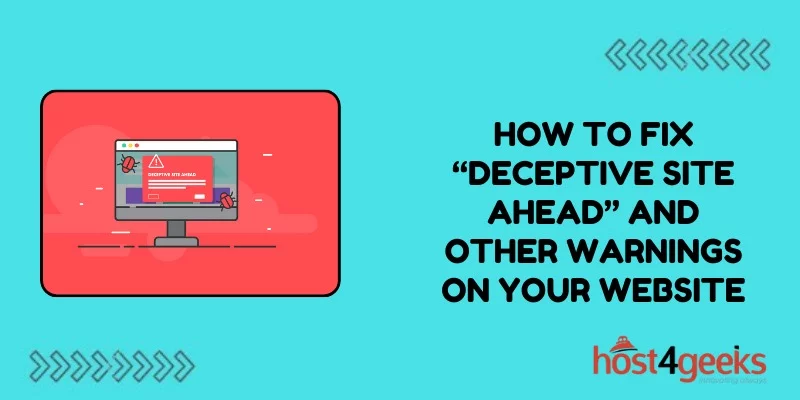Seeing ominous browser warnings like “Deceptive site ahead” or “Reported web forgery” and other Warnings on your website is alarming. These frustrating messages indicate that your site triggered red flags with browsers or security scanners as potentially malicious, phishing, or infected with viruses or malware.
While extremely concerning, these warnings can usually be remediated by pinpointing the specific cause and taking targeted actions to resolve it. With some diligent troubleshooting and debugging, you can remove the warnings and restore your site’s reputation as safe and legitimate.
Potential Triggers for Browser Warnings
There are a number of reasons browsers and security tools display warnings for websites:
- Active Malware or Virus Infection – If your site has been compromised and is distributing malware or viruses, this malicious activity will trigger instant warnings. Scanners automatically detect the threats.
- Phishing or Fraud Pages – Any pages imitating real sites like banks, shops, or other businesses to steal user information will be flagged as deceptive and dangerous.
- Suspicious Redirect Activity – Frequently redirecting users to known malicious sites or questionable content can indicate potential phishing behavior.
- Problematic Third-Party Code – Poorly developed or vulnerable widgets, libraries, or other third-party code included on your site may enable malicious actions.
- Disreputable Affiliate Links or Ad Networks – Low-quality affiliate programs and ad networks with little oversight can sometimes contain or distribute threats that get flagged.
- Expired or Invalid SSL Certificate – Using a self-signed certificate, expired certificate, or mismatching domain on the certificate makes the site appear less legitimate and credible to browsers.
- Shared Hosting Server’s Poor Reputation – Other abusive or infected sites hosted on the same server IP can negatively impact the reputation for all sites on that server.
- Over-Optimization of SEO – In some cases, extremely spammy SEO tactics like keyword stuffing or questionable link building backfire.
Diagnosing and Removing Browser Warnings
Now let’s explore the steps you can take to pinpoint the cause of warnings and carry out the appropriate remediation:
Perform Comprehensive Malware and Virus Scans
Run full scans with malware detection tools like Malwarebytes to check for any infections or compromised files. Remove any threats found and restore original clean versions of infected files.
Audit Pages for Phishing Attempts
Manually review all pages on your site for any potential phishing scams, especially those impersonating banks, online shops, and other popular services. Take down any fraudulent pages.
Check Redirect Sources and Destinations
Thoroughly audit any redirects implemented on your site through .htaccess rules, Javascript or meta tags. Ensure they do not link to known malicious sites.
Assess Third-Party Code and Dependencies
Take stock of all third-party code and dependencies in use on your site. Research them to check for any vulnerabilities or malicious actions.
Analyze Affiliate Links and Ad Networks
Vet all affiliate programs and ad networks being used. Avoid any with histories of propagating malware, showing deceptive ads, or other shady practices.
Install a Valid SSL Certificate
Use an SSL certificate testing tool like SSL Labs to debug any issues with your current SSL certificate. Purchase and install a valid certificate from a reputable authority.
Request IP Reputation Review by Hosting Provider
If your site is on shared hosting, ask the provider to investigate other potentially infected or abusive sites on the server. They can remove accounts violating policies.
Clean Up Suspicious SEO Techniques
Eliminate any spammy SEO tactics like keyword stuffing, hidden text, and questionable links. Focus on ethical optimization best practices instead.
File Reconsideration Request in Search Console
Use Google Search Console to report incorrect malware warnings. Google may re-review your site’s reputation.
Temporarily Move Domains
As a last resort, temporarily change your site’s domain name. This gives you a fresh start without association with previous warnings.
With persistence and systematic troubleshooting, you can uncover the specific cause of warnings and carry out appropriate fixes. This will clear warnings and restore your site as a trusted destination in all browsers.
Concluding Thoughts
In closing, warnings like “Deceptive site ahead” raise red flags but can be remedied. By taking stock of site elements like third-party code, redirects, SSL certificates, SEO tactics, and shared hosting reputation, you can track down the source of warnings.
Addressing identified issues directly through malware removal, phishing page takedowns, eliminating shady links, or even switching domains will remove warnings and rebuild site trust. Do not panic – just focus on pinpointing and fixing the factors triggering warnings through a careful debugging process.
